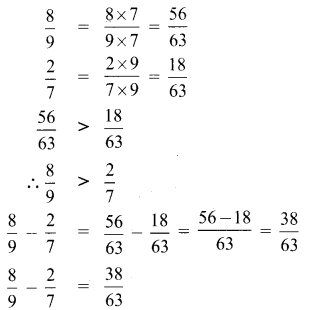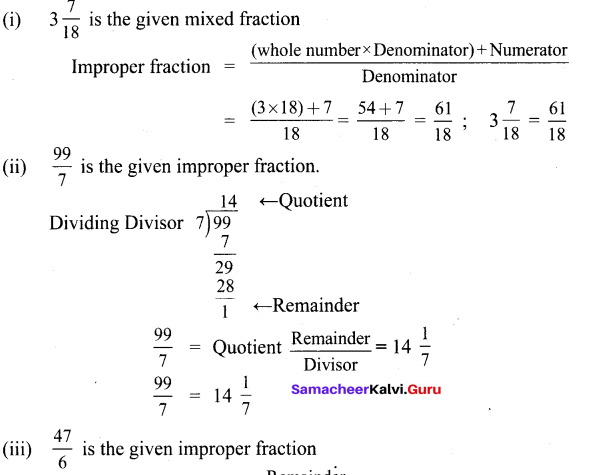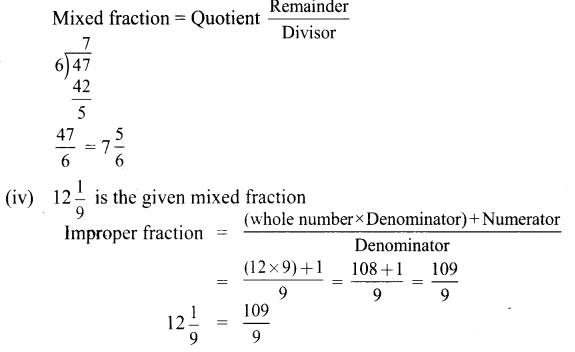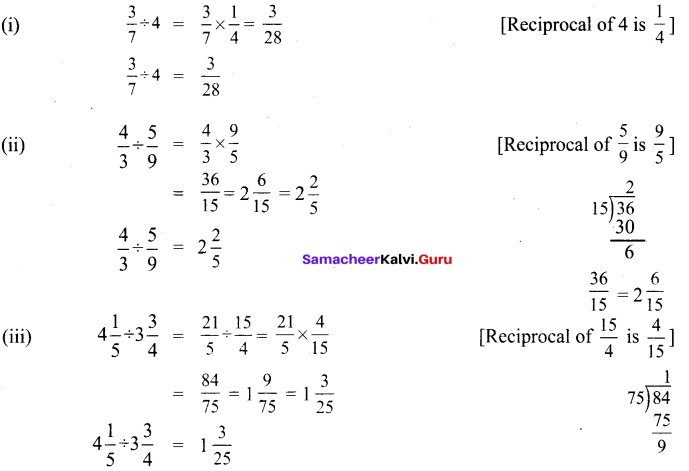You can Download Samacheer Kalvi 6th Maths Book Solutions Guide Pdf, Tamilnadu State Board help you to revise the complete Syllabus and score more marks in your examinations.
![]()
Tamilnadu Samacheer Kalvi 6th Maths Solutions Term 3 Chapter 1 Fractions Ex 1.1
Question 1.
Fill in the blanks.
(i) 7\(\frac{3}{4}\) + 6\(\frac{1}{2}\) = _______
(ii) The sum of whole number and a proper fraction is called ______
(iii) 5\(\frac{1}{3}\) – 3\(\frac{1}{2}\) = ______
(iv) 8 ÷ \(\frac{1}{2}\) = ______
(v) The number which has its own reciprocal is _______.
Solution:
(i) 14\(\frac{1}{4}\)
(ii) Mixed Fraction
(iii) 1\(\frac{5}{6}\)
(iv) 16
(v) 1
Question 2.
Say True or False
(i) 3\(\frac{1}{2}\) can be written as 3 + \(\frac{1}{2}\).
(ii) The sum of any two proper fractions is always an improper fraction.
(iii) The mixed fraction of \(\frac{13}{4}\) is 3\(\frac{1}{4}\).
(iv) The reciprocal of an improper fraction is always a proper fraction.
(v) 3\(\frac{1}{4}\) × 3\(\frac{1}{4}\) = 9\(\frac{1}{16}\)
Solution:
(i) True
(ii) False
(iii) True
(iv) True
(v) False
![]()
Question 3.
Answer the following :
Solution:
(i) Find the sum of \(\frac{1}{7}\) and \(\frac{3}{9}\)

(ii) What is the total of 3\(\frac{1}{3}\) and 4\(\frac{1}{6}\).

(iii) Simplify : 1\(\frac{3}{5}\) + 5\(\frac{4}{7}\)

(iv) Find the difference between \(\frac{8}{9}\) and \(\frac{2}{7}\)

(v) Subtract 1\(\frac{3}{5}\) and 2\(\frac{1}{3}\)

(vi) Simplify: 7\(\frac{2}{7}\) – 3\(\frac{4}{21}\)

Question 4.
Convert mixed fraction into improper fractions and vice versa:

Solution:


![]()
Question 5.
Multiply the following :
![]()
Solution:


Question 6.
Divide the following:

Solution:


Question 7.
Gowri purchased 3\(\frac{1}{2}\) kg of tomatoes, \(\frac{3}{4}\) kg of brinjal and 1\(\frac{1}{4}\) kg of onion, what is the total weight of the vegetables she bought?
Solution:
Weight of tomatoes Gowri purchased = 3\(\frac{1}{2}\) kg
Weight of Brinjal purchased = \(\frac{3}{4}\) kg

Total weight of vegetables that Gowri purchased = 5\(\frac{1}{2}\) kg
![]()
Question 8.
An oil tin contains 3\(\frac{3}{4}\) litres of oil of which 2\(\frac{1}{2}\) litres of oil is used. How much oil is left over?
Solution:

Quantity of oil leftover = 1\(\frac{1}{4}\) litres.
Question 9.
Nilavan can walk 4\(\frac{1}{2}\)km in an hour. How much distance will he cover in 3\(\frac{1}{2}\) hours?
Solution:
Distance walked by Nilavan in one hour = 4\(\frac{1}{2}\) km.

Nilavan walks 15\(\frac{3}{4}\) km in 3\(\frac{1}{2}\) hours
![]()
Question 10.
Ravi bought a curtain of length 15\(\frac{3}{4}\) m. If he cut the curtain into small pieces each of length 2\(\frac{1}{4}\) m, then how many small curtains will he get?
Solution:

Objective Type Questions
Question 11.
Whcih of the following statement is incorrect?

Solution:
(d)\(\frac{10}{11}<\frac{9}{10}\)
Hint:

Question 12.
The difference between \(\frac{3}{7}\) and \(\frac{2}{7}\) is

Solution:
(a) \(\frac{13}{63}\)
Hint:

Question 13.
The reciprocal of \(\frac{53}{17}\) is

Solution:
(c) \(\frac{17}{53}\)
Hint:
\(\frac{\frac{1}{53}}{\frac{53}{17}}=\frac{17}{53}\)
![]()
Question 14.
If \(\frac{6}{7}\) = \(\frac{A}{49}\), then the value of A is
(a) 42
(b) 36
(c) 25
(d) 48
Solution:
(a) 42
Question 15.
Pugazh has been given four choices for his pocket money by his father. Which of the choices should he take in order to get the maximum money?
![]()
Solution:
(c) \(\frac{4}{5}\) of ₹150